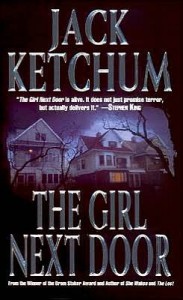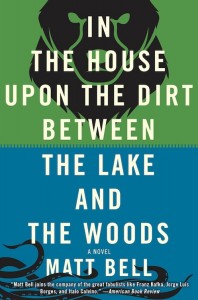Jack Ketchum’s The Girl Next Door
 The Girl Next Door
The Girl Next Door
by Jack Ketchum
Leisure Books, 2005
370 pages / Buy from Amazon
One principle guiding this year’s reading has been to delve more deeply into what’s filed under Horror. When people ask me what kind of stuff I write, I always struggle with that word, never quite sure what it’ll mean to them when I do or don’t use it. I like the word, and generally think of what I do as drawing from that side of things, but I’ve never 100% known, reading-wise, what it encompasses.
So this year I read some of the classics and tried to ground myself in the contemporary, English-language tradition of the genre: Stephen King (whose name has obviously loomed forever but whose work, aside from On Writing, I’d never really read), Thomas Ligotti (phenomenal, someone I hope to write about soon), Todd Grimson, Ramsey Campbell (cool in both senses of the word), Joe Hill (got a huge kick out of NOS4A2, though probably enough has been said about that book by now), Shirley Jackson, Dennis Etchison, Robert Shearman, Laird Barron, Bret Easton Ellis (crucial in his own way) … and Jack Ketchum.
Of everything I took in under these auspices, Ketchum’s The Girl Next Door hit me hardest. A few months later, it’s still in there, growing, helping me not forget that life’s a problem.
I could go on about its take on 60’s small-town American life and its amazingly apt and tender portrayal of boyhood and the loss of innocence and the rush of discovery when one’s own destructive urges first flare up, but what really tore this book into my lining was the surprising but inarguable way it distinguished the Banality of Evil (which everyone has) from something deeper, worse – call it the Uniqueness of Evil (which only some people have … or maybe they’re not even people at that point).
The premise, based loosely on a real crime committed in Indiana in 1965: a smart, hip NYC girl, Meg, and her disabled sister come to stay with their cousins and their freaky, bitter aunt in a New Jersey town after their parents are killed in a car crash. David, the narrator and boy next door, falls for Meg as soon as he meets her. Her worldliness, older-seeming-ness, the fact that she’s not a tiny-minded bigot … she doesn’t have to do much more than show up to introduce him to his “adolescence head-on.”
Things take their sweet, romantic time, all summery creekside flirtation and town funfairs, until Ruth, the sado-aunt, decides to imprison Meg in her bomb-shelter basement, claiming, in a fit of sanctimonious insanity, that she’s gonna teach the girl how not to be a slut and thereby spare her the grim fate of all women.
Thus the book enters its Banality of Evil phase, incrementally uncovering the dumb violence housed in Ruth’s sons and their neighborhood friends, David included: the way in which they all, horny and hopped-up on monster mags and hearsay, can’t resist the temptation of a hot girl chained and the freedom to lord themselves over her.
Under Ruth’s strict guidance, they torment the captive, dancing up to and back from the edge of sexual transgression, and torment themselves as well, wondering how far they’ll go, and how much it means to have an adult’s permission to go there … wondering whether going too far is inevitable or forbidden, and whether the deeper regret will prove to be doing or not doing the things they most want to do.
David hovers unstably between wanting to protect this girl he’s fallen for and wanting to relish the chance to see and touch her naked, to replace his normal teen fantasy with abnormal, unearned reality. “She was all I knew of sex,” he admits, “and all I knew of cruelty.”
Overcoming his initial revulsion and sense of wrongness, and thereby dismissing the only warning that could have saved Meg’s life because things are just getting started at this point, he stands by as “shame looked square in the face of desire and looked away again.”
All of this emotional development isn’t just the perfunctory “make the reader care about them so it’s scary when they get slaughtered” legwork. There’s something in David’s relationship to Meg and to the other, more easily unhinged boys, that rings absolutely true to the feeling of growing up and wanting to belong both to the species and to yourself, and to be one with your friends while also pursuing the things that take you away from them – both love and lust, doled out in equal parts tenderness and ferocity.
This whole Banality of Evil section is a masterpiece of denial and self-justification (and as good a Holocaust metaphor as I’ve seen), charting the ways in which David and the other boys combine permission and desire into a driving force that grossly trumps mercy. It’s as if the extremity of it all, the sense that it couldn’t be happening, excuses it, making it almost as though it isn’t happening, or at least promising that in retrospect, once they’ve had their fun and rite of passage, it won’t have happened for real.
January 13th, 2014 / 11:00 am
The Girlfriend Game
 The Girlfriend Game
The Girlfriend Game
by Nick Antosca
Word Riot Press, June 2013
174 pages / $15.95 Buy from Word Riot or Amazon
“Every time we play the game, it brings us a little closer together.” So declares the title story of Nick Antosca’s poignant and feral new collection.
It’s not incidental that the book takes its title from this story. Grittier and less gothically stylized than Midnight Picnic (though quasi-supernatural dogs are no less present), the twelve stories collected here are about human closeness – the lack of it, the search for it, and the fear of it when it comes. They open with the premise of men and women drawing one another in, and play out the game that follows until some grim resolution brings that round to an end, sometimes sparing the players and sometimes not.
There are ample rat beasts, humanoid amphibians, alien landings, and panic-inducing weather patterns crowding the sky, but what’s scariest here are the ways in which, as a professor forlornly sleeping with her student puts it, “there was no escaping it, the violent strangeness of people.” Unlike in more common horror writing, where the monstrous crawls in unbidden from the basement or from another dimension, the people in Antosca’s stories call it up in one another, and access it via others in themselves.
In many of these stories, which tend to center on depressive twentysomethings in nondescript Brooklyn-based situations, people pursue one other across spiritual and geographical distances, often out of the city and into the woods. The woods, as in Midnight Picnic, are at once a sanctum of simplicity and innocence, and an arena for unleashing extreme and unpunished violence. Their sparseness of population seems to offer relief from the city’s human weight, but, as a setting for a certain kind of showdown, they serve an opposite purpose: they draw the pursuer and the pursued closer together by purging all witnesses and middlemen.
Weirdly, the violence this enables becomes a form of innocence. Beneath all the Facebook and iPhone surface noise, The Girlfriend Game fleshes out a primitive vision of society where dismemberment with knives and meathooks is a valid and even productive mode of interaction. It’s maybe the only way to play the game without tricking the other person. As one woods-bound narrator puts it, “I began to understand that only one thing might bring me peace – not fantasies of murder, but murder. I started planning.”
There are no misfires, but my four favorite stories are “Mammals,” the most purely horrific, “Winter Was Hard,” the baddest-ass, “Migrations,” the saddest and most enigmatic, and “Carnal Quartet,” which nails the vibe of darkening post-coital rooms where a hint of dread – maybe just passing time, maybe something demonic and amiss – creeps in to divide the dozing lovers, while at the same time enveloping them both.
August 9th, 2013 / 11:00 am
In The House Upon The Dirt Between The Lake And The Woods
 In The House Upon The Dirt Between The Lake And The Woods
In The House Upon The Dirt Between The Lake And The Woods
by Matt Bell
Soho Press, June 2013
312 pages / $15.27-25 Preorder from Amazon or Soho Press
It’s too easy to describe Matt Bell’s work as mythic. A lot about it is, but what makes it such a valuable addition to the field of stuff you can read is not just the way it draws from and modernizes mythic structures, but the way it burns through those structures to touch the awe and terror that gave rise to them. In The House Upon The Dirt Between The Lake And The Woods, his phenomenal debut novel, tells a story about barrenness and fertility that is also a story about the fight to heave off the expectations and limitations of mythic storytelling.
Bell writes with the leisurely flow of an oral epic, and his unnamed, communally defined characters (“my wife,” “our false son”) have as much lineage in ancient Greece and Scandinavia as they do in contemporary America, but instead of aspiring to the oral epic’s universal openness, In The House aspires to its own brand of claustrophobic intimacy. The narrator speaks like a bard but his story is his own, his voice unmistakably first-person.
This story is filled with quests, labyrinths, and totem animals, taking its shape partly from Orpheus (a husband seeks his wife along a seemingly never-ending downward path), and partly from Faust (this man fends off invitations to cowardice offered by a devilish miscarried boy living in his guts), but it strips these familiar elements of their cultural baggage and moral agendas. Free of what’s boring and overdetermined about them, they start to feel a lot stranger and more dangerous.
May 24th, 2013 / 11:00 am
